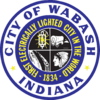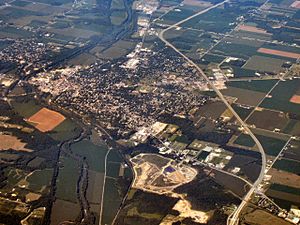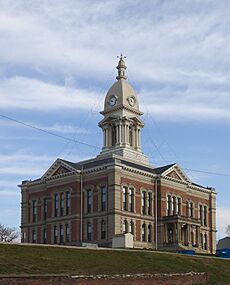Wabash, Indiana facts for kids
Quick facts for kids
Wabash, Indiana
|
|||
|---|---|---|---|
| City of Wabash | |||
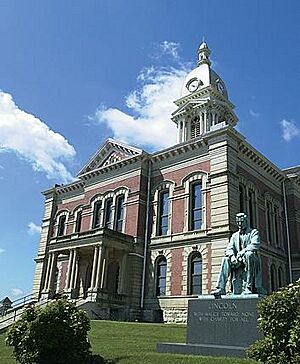
Wabash County Courthouse with Lincoln Monument
|
|||
|
|||
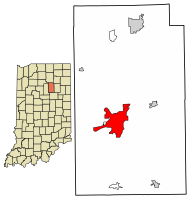
Location of Wabash in Wabash County, Indiana.
|
|||
| Country | United States | ||
| State | Indiana | ||
| County | Wabash | ||
| Township | Noble | ||
| Government | |||
| • Type | Mayor-council government | ||
| Area | |||
| • Total | 9.87 sq mi (25.57 km2) | ||
| • Land | 9.64 sq mi (24.96 km2) | ||
| • Water | 0.24 sq mi (0.62 km2) 2.63% | ||
| Elevation | 751 ft (229 m) | ||
| Population
(2020)
|
|||
| • Total | 10,440 | ||
| • Density | 1,083.44/sq mi (418.33/km2) | ||
| Time zone | UTC-5 (EST) | ||
| ZIP code |
46992
|
||
| Area code(s) | 260 | ||
| FIPS code | 18-79370 | ||
| GNIS feature ID | 2397155 | ||
| Website | www.cityofwabash.com | ||
Wabash is a city in Wabash County, Indiana. It is located along the Wabash River. In 2010, about 10,666 people lived there. Wabash is famous for being one of the first cities in the world to use electric lights. This happened on March 31, 1880, when the courthouse grounds were lit up.
The city is also home to several important places. These include the historic Eagles Theatre and the Paradise Spring Treaty Grounds. The old Wabash and Erie Canal also runs through the area.
Contents
What's in a Name?
The name Wabash comes from a Miami-Illinois word. It means "water over white stones." This name describes how clear the Wabash River was. You could see the limestone river bottom in Huntington County, Indiana.
Wabash City History
Early Settlers and Growth
The first people settled in Wabash in 1829. This happened after the Paradise Spring treaty. The town of Wabash was officially planned in 1834. It was designed by Col. Hugh Hanna and Col. David Burr. Wabash was chosen as the main city for Wabash County.
The town grew quickly because it was close to the Wabash and Erie Canal. This canal helped transport goods and people. In 1870, a big fire destroyed the Wabash County Courthouse and much of the downtown area. But the city worked hard and recovered. The building of the Big Four Railway helped the town grow even more. However, this also meant the canal was used less.
The First Electric Lights
Wabash made history on March 31, 1880. It was one of the first places to use a new type of electric light. These were carbon arc lights, invented by Charles Brush. Four powerful lamps, each 3,000-candle power, were hung from the top of the courthouse. Wires connected the lamps to a generator in the courthouse basement. A 12-horsepower steam engine powered the generator. This brought electric light to the city.
Historic Places in Wabash
Many buildings and areas in Wabash are very old and important. They are listed on the National Register of Historic Places. Some of these include:
- James M. Amoss Building
- Downtown Wabash Historic District
- East Wabash Historic District
- First Christian Church
- Honeywell Memorial Community Center
- Honeywell Studio
- McNamee-Ford House
- North Wabash Historic District
- West Wabash Historic District
- Solomon Wilson Building
Wabash Geography
The Wabash River flows through the city. It continues towards Peru. In Peru, the river splits, creating several islands. Sandbars are also common in this part of the river.
Wabash covers a total area of about 9.128 square miles (23.64 square kilometers). Most of this area, about 8.89 square miles (23.02 square kilometers), is land. The rest, about 0.238 square miles (0.62 square kilometers), is water.
Wabash Climate and Weather
| Climate data for Wabash, Indiana, 1991–2020 normals, extremes 1925–present | |||||||||||||
|---|---|---|---|---|---|---|---|---|---|---|---|---|---|
| Month | Jan | Feb | Mar | Apr | May | Jun | Jul | Aug | Sep | Oct | Nov | Dec | Year |
| Record high °F (°C) | 70 (21) |
74 (23) |
82 (28) |
91 (33) |
98 (37) |
104 (40) |
109 (43) |
103 (39) |
102 (39) |
92 (33) |
86 (30) |
70 (21) |
109 (43) |
| Mean maximum °F (°C) | 55.3 (12.9) |
59.0 (15.0) |
71.3 (21.8) |
80.6 (27.0) |
87.7 (30.9) |
92.2 (33.4) |
92.1 (33.4) |
91.2 (32.9) |
89.9 (32.2) |
83.3 (28.5) |
69.0 (20.6) |
57.5 (14.2) |
94.1 (34.5) |
| Mean daily maximum °F (°C) | 33.8 (1.0) |
38.0 (3.3) |
48.9 (9.4) |
61.9 (16.6) |
73.1 (22.8) |
81.6 (27.6) |
84.8 (29.3) |
83.0 (28.3) |
77.6 (25.3) |
65.5 (18.6) |
51.0 (10.6) |
38.4 (3.6) |
61.5 (16.4) |
| Daily mean °F (°C) | 25.9 (−3.4) |
29.2 (−1.6) |
39.1 (3.9) |
50.7 (10.4) |
62.0 (16.7) |
71.0 (21.7) |
74.2 (23.4) |
72.4 (22.4) |
66.0 (18.9) |
54.3 (12.4) |
41.7 (5.4) |
30.9 (−0.6) |
51.5 (10.8) |
| Mean daily minimum °F (°C) | 17.9 (−7.8) |
20.3 (−6.5) |
29.2 (−1.6) |
39.6 (4.2) |
50.9 (10.5) |
60.5 (15.8) |
63.6 (17.6) |
61.7 (16.5) |
54.4 (12.4) |
43.1 (6.2) |
32.5 (0.3) |
23.5 (−4.7) |
41.4 (5.2) |
| Mean minimum °F (°C) | −3.8 (−19.9) |
0.9 (−17.3) |
10.6 (−11.9) |
23.4 (−4.8) |
34.5 (1.4) |
45.2 (7.3) |
51.7 (10.9) |
50.6 (10.3) |
39.8 (4.3) |
29.0 (−1.7) |
18.4 (−7.6) |
4.2 (−15.4) |
−7.7 (−22.1) |
| Record low °F (°C) | −24 (−31) |
−22 (−30) |
−13 (−25) |
4 (−16) |
23 (−5) |
30 (−1) |
41 (5) |
34 (1) |
25 (−4) |
16 (−9) |
−3 (−19) |
−21 (−29) |
−24 (−31) |
| Average precipitation inches (mm) | 2.41 (61) |
2.25 (57) |
2.63 (67) |
3.54 (90) |
4.36 (111) |
4.88 (124) |
4.56 (116) |
4.20 (107) |
3.20 (81) |
3.06 (78) |
2.91 (74) |
2.34 (59) |
40.34 (1,025) |
| Average snowfall inches (cm) | 7.3 (19) |
4.8 (12) |
2.4 (6.1) |
0.4 (1.0) |
0.0 (0.0) |
0.0 (0.0) |
0.0 (0.0) |
0.0 (0.0) |
0.0 (0.0) |
0.0 (0.0) |
1.0 (2.5) |
3.6 (9.1) |
19.5 (49.7) |
| Average precipitation days (≥ 0.01 in) | 9.4 | 7.7 | 9.7 | 10.8 | 12.3 | 12.2 | 10.0 | 8.7 | 8.7 | 9.1 | 9.7 | 8.9 | 117.2 |
| Average snowy days (≥ 0.1 in) | 4.3 | 2.4 | 1.4 | 0.2 | 0.0 | 0.0 | 0.0 | 0.0 | 0.0 | 0.0 | 0.6 | 2.2 | 11.1 |
| Source 1: NOAA | |||||||||||||
| Source 2: National Weather Service | |||||||||||||
People of Wabash
How Many People Live Here?
In 2010, there were 10,666 people living in Wabash. These people lived in 4,465 households. About 2,805 of these were families. The city had about 1,199.8 people per square mile (463.2 people per square kilometer).
Most people in Wabash are White (96.3%). There are also smaller groups of African American, Native American, and Asian people. About 2.0% of the population is Hispanic or Latino.
Families and Age Groups
About 29.3% of households had children under 18 years old. Many households (45.7%) were married couples living together. About 32.6% of households were single people. Also, 14.9% of households had someone aged 65 or older living alone.
The average age in Wabash was 41.3 years old. About 22.5% of residents were under 18. About 18.8% were 65 or older. The city had slightly more females (52.8%) than males (47.2%).
Arts and Fun in Wabash
The Eagles Theatre
The Eagles Theatre first opened on March 30, 1906. It was built for vaudeville shows, which were popular at the time. In the late 1920s, it was updated by architect Alvin M. Strauss. By the 1930s, it started showing movies. More changes were made in 1939, giving it an Art Deco style.
The Eagles Theatre has one of the biggest movie screens in Indiana. It also has two balconies and a ballroom. This historic theater was added to the National Register of Historic Places in 1985.
The Honeywell Center
The Honeywell Center is a place for performing arts in downtown Wabash. Building started in 1940 but was paused until 1957. In 1997, a large addition was built. This included the Ford Theater, which has 1,500 seats. It also added Eugenia's Restaurant and an art gallery.
Wabash Economy
The Honeywell Corporation started in Wabash in the 1880s. It still has a strong presence in the city today. Wabash is also home to The Ford Meter Box Company. This company makes important equipment for the water industry.
Many other smaller companies are in Wabash. These include Papers Industries Inc., Beacon Credit Union, and Thermafiber, Inc. The Metropolitan School District also provides many jobs in the city.
Places of Worship
The largest church group in Wabash is the United Methodist Church. Other churches in the city include:
- Presbyterian
- Church of the Nazarene
- Catholic
- Christian
- Baptist
- Wesleyan
- Pentecostal
Learning in Wabash
Colleges and Universities
There are two universities close to Wabash. They are both within 20 miles (32 kilometers) of the city.
- Manchester University is in North Manchester.
- Huntington University is in Huntington.
Schools for Kids
Wabash has several schools for younger students:
- OJ Neighbours Elementary School
- Meroby Elementary School
- St Bernard Elementary School
- Wabash Middle School
- Wabash High School
The city also has a public library where you can borrow books. It's called the Wabash Carnegie Public Library.
Notable People from Wabash
Many interesting people have come from Wabash:
- Michael Baber - a music and sound editor.
- Adelaide Steele Baylor - a federal education official.
- Loren M. Berry – a pioneer of the Yellow Pages telephone directory.
- Rick Brandenburg – an entomologist (someone who studies insects).
- John W. Corso – an art director and production designer.
- John P. Costas - a telecommunications engineer.
- James E. Dabler - an Illinois state representative and businessman.
- Jimmy Daywalt – a race car driver.
- Charles Dingle - an actor.
- Gus Dorais – a football player and coach.
- Crystal Gayle - a famous country singer.
- Mark Honeywell – the founder of the Honeywell Corporation.
- Howard A. Howe - a polio researcher.
- O. P. Hubbard - a member of the Alaska Senate.
- Bobby Jones – a National Football League player.
- Joaquin Miller - a poet and frontiersman.
- George Mullin - a Major League Baseball player.
- Keith O'Conner Murphy - a Rockabilly Hall of Fame singer and songwriter.
- Margie Stewart - a U.S. Army poster girl during World War II.
Images for kids
-
Old Warehouse, which backs up on the Wabash and Erie Canal
See also
 In Spanish: Wabash (Indiana) para niños
In Spanish: Wabash (Indiana) para niños



